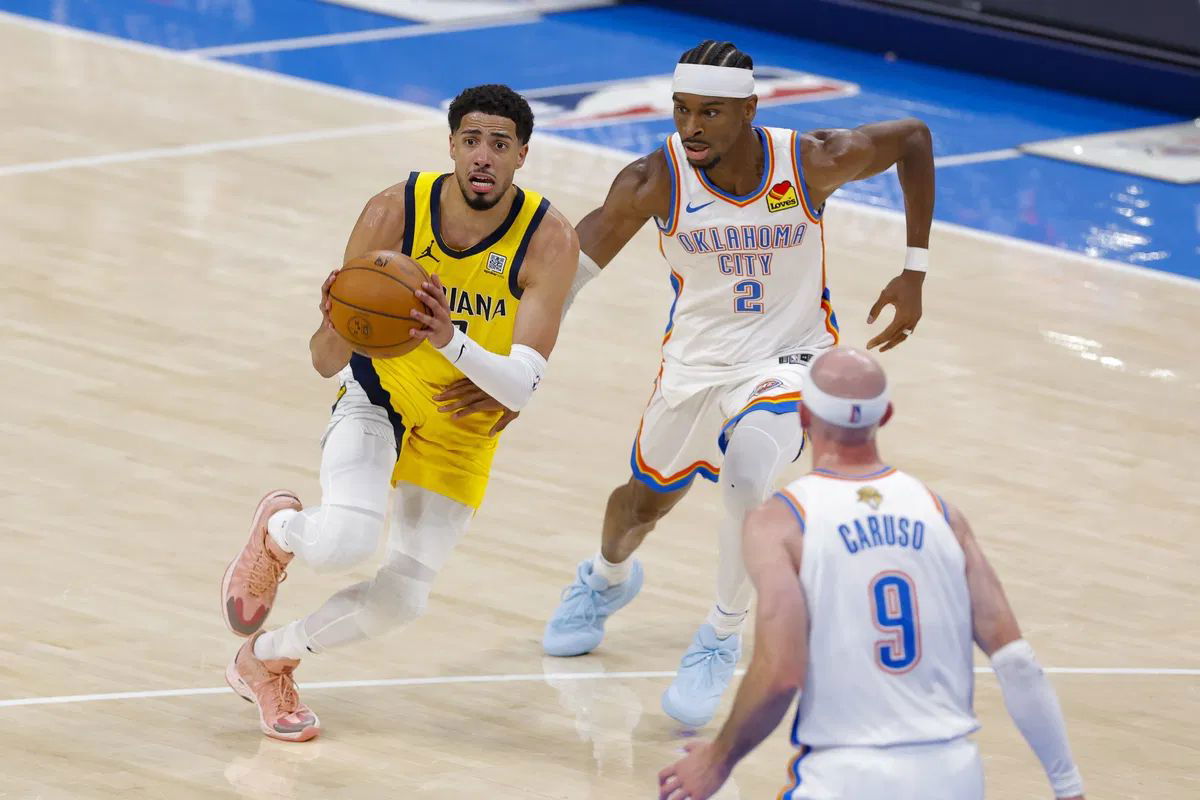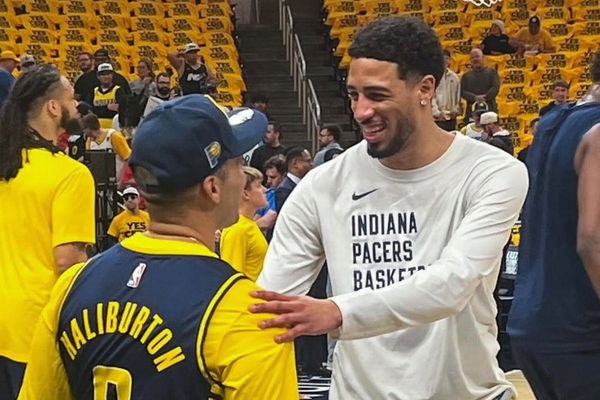
Imago
Jun 5, 2025; Oklahoma City, Oklahoma, USA; Indiana Pacers guard Tyrese Haliburton (0) passes the ball past Oklahoma City Thunder guard Shai Gilgeous-Alexander (2) during the second quarter during game one of the 2025 NBA Finals at Paycom Center. Mandatory Credit: Alonzo Adams-Imagn Images

Imago
Jun 5, 2025; Oklahoma City, Oklahoma, USA; Indiana Pacers guard Tyrese Haliburton (0) passes the ball past Oklahoma City Thunder guard Shai Gilgeous-Alexander (2) during the second quarter during game one of the 2025 NBA Finals at Paycom Center. Mandatory Credit: Alonzo Adams-Imagn Images
No one saw this coming. Not in December when they were 16-18. Not in March when the East looked locked up. Not even when they barely scraped into the playoffs. But here we are—48 minutes away from the unthinkable. The Indiana Pacers, once written off as an afterthought, now stand one win away from completing what might be the most outrageous heist in NBA history. Game 7. On the road. Against the MVP. If they pull this off, it won’t just be a title—it’ll be the most improbable championship run the league has ever seen.
Watch What’s Trending Now!
Forget 2011’s Mavericks. That team had Dirk Nowitzki, a top-10 legend, steering the ship. Forget LeBron’s miracle in 2016. That was magic—yes—but it was magic performed by LeBron, Kyrie, and Kevin Love. The Pacers? They’re built differently. They don’t rely on superstardom. They run on rhythm, belief, and a refusal to die. A title wouldn’t just be a win—it’d be the stuff of documentaries. Something passed down, retold, and remembered.
ADVERTISEMENT
The Paul George trade tree—How a historic deal shaped the rosters of two NBA finalists
To understand how unlikely this is, you have to look at the numbers. The Pacers are trying to win a title with no player averaging 20 points per game in the Finals; Pascal Siakam, the EC MVP, leads them at 19.8. Their payroll is 21st in the league. Their third-leading scorer in this series is Obi Toppin, who started only four games this season. Their most important player in clutch moments might be T.J. McConnell, an undrafted guard whose energy now forces opposing coaches to game-plan around him. This team defies the modern, star-driven model for winning.
The origins of this roster add another layer to the story. This Finals matchup was indirectly created by trades involving former Pacer Paul George. In 2017, Indiana sent a disgruntled George to Oklahoma City for Victor Oladipo and Domantas Sabonis. Years later, they traded Sabonis for their current star point guard, Tyrese Haliburton. The Thunder, meanwhile, sent George to the Clippers in 2019 for a haul of draft picks and, crucially, Shai Gilgeous-Alexander. As one scout told Front Office Sports, “George built these Finals rosters more than anyone else.” It’s a full-circle moment that feels years in the making.
But despite this lore, no one expected this. As Tyrese Haliburton said before Game 7, the expectations for this group were never high—not entering the playoffs, not in the second round, and not now. And he’s right. This team was built on execution, not hype. When asked how they’ve elevated their play, Haliburton was direct: “I think we just do a great job of sticking with our system… we’re competitive guys. We want to compete against the best.”
ADVERTISEMENT

ADVERTISEMENT
That system, and the belief behind it, now faces its ultimate test in a game defined by fascinating matchups. As Tyrese Haliburton prepares for the biggest night of his life, he’s thinking about the history of the moment. When asked about the last great Finals Game 7—the 2016 battle between the Cavaliers and Warriors—Haliburton said, “That’s probably one of the greatest games I’ve ever been able to watch as a basketball fan. I’m excited to add to… the storied history of Game 7.”
ADVERTISEMENT
Echoes of Jordan and Magic—The finals are a battle of opposing philosophies
This game’s core conflict pits two young, opposing stars against each other, but this also has historical connotations attached to it. Analysts have compared SGA’s methodical mid-range game to Michael Jordan’s. Haliburton is the opposite: a pass-first point guard who runs the offense with an unselfish flair reminiscent of Magic Johnson.
The contrast brings to mind the 1991 Finals, where Jordan’s Bulls signaled a shift away from Magic’s pass-first era. Now, a new generation is defining the league’s most important position. And for both young stars, legacy is on the line. Contrary to LBJ’s criticisms of the “ring culture,” both Haliburton and SGA have been clear that a championship is what matters most. “If you win it, you get everything. If you lose it, you get nothing. It’s that simple,” SGA said after Game 6. And despite James’s critiques, his own career proves their point. Had he not won his iconic, legacy-defining titles in 2013 and 2016, the conversation around his career would be entirely different.
The rivalry also extends to the coaches. In one corner is OKC’s Mark Daigneault, the Coach of the Year, whose innovative schemes have been praised all season. In the other is Rick Carlisle, the 65-year-old veteran who already has a championship. We’ve seen Daigneault’s brilliance in a Game 4 comeback, but also his potential inexperience in a Game 1 collapse. We saw Carlisle’s stubbornness in Game 5 when he stuck with a hobbled Haliburton instead of a hot T.J. McConnell. As Tim MacMahon noted, it’s a duel between an “old-school” coach who trusts veterans and a “new-school” one who trusts “the algorithm and youth.”
ADVERTISEMENT
These high-stakes coaching decisions and on-court duels are not just about winning one game, they set the stage for a result that could have league-altering consequences.
A Pacers title would completely reshape NBA league strategy
A Pacers championship would change how front offices think about building a team. For the past decade, the league has been defined by “superteams.” The NBA’s new collective bargaining agreement (CBA) is designed to end that era. With its harsh “second apron” luxury tax, the CBA makes it financially difficult to load a roster with multiple max-contract stars. The Phoenix Suns, who had the league’s highest payroll, didn’t even make it out of the first round.
As Brian Windhorst said, teams like the Pacers have “become the poster child for how to win in the second-apron era.” The Pacers and the Thunder are the new model. They are two small-market teams built through smart drafting and trades, not splashy free-agent signings. They are young, deep, and versatile. This Finals matchup is a preview of the NBA’s future.
It also reflects Adam Silver’s vision of a global league. The court is filled with international talent: SGA and his Canadian countrymen Bennedict Mathurin and Andrew Nembhard, alongside Cameroon’s Pascal Siakam. This is a global game now, and these two teams are the proof.
If the Pacers win Game 7 in one of the league’s toughest arenas, it will send a message to every other team: you don’t need a major market or three superstars to win. You need a smart front office, a deep roster, and a group of players who believe in each other.
Kevin O’Connor of The Ringer described Indiana’s run as “a masterclass in adaptation and balance,” noting how Carlisle has “weaponized role players in ways we rarely see.” If this overlooked and resilient Pacers team pulls this off, it won’t just be an incredible underdog story. It will mark the beginning of a new way to win in the NBA.
ADVERTISEMENT
ADVERTISEMENT
ADVERTISEMENT

